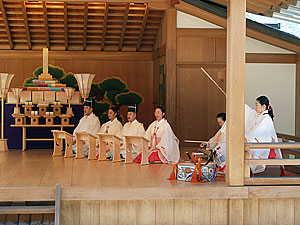There are just human tears and human joy
By Bill Roberts
Bill Roberts gave this speech at the Kobe branch on Feb. 11, 2007.
Konichiwa. Bill Roberts des. Yoroshiku. Onegaishimasu.
I am honored to visit the Kobe branch and attend your tsukinamisai. I began to visit Oomoto branches in 2001, and I have lost count of how many I have been to. It must be 15 or more now.
Most of those visits were to conduct research for my book, “A Portrait of Oomoto.” As you know it was published by Tenseisha Press one year ago.
It is now appearing serially in Japanese in Matsugokoro, the monthly publication of the Oomoto Headquarters Youth Division. Each installment is also posted on the home page of Jinrui Aizen-kai.
I would like to take this opportunity to present a copy of the book to your branch to add to your library. Some of you might at least enjoy looking at the photos.
[ask branch chief to come up].
I would also like to present you with a photo book I put together of the trip to Meshima in 2005. I believe I was the only foreigner ever allowed to participate in this sacred event. I feel quite honored.
The first chapter of my book is all about Meshima. Many Americans who have read the book were quite enthralled with the story and the photos.
Now that my book is published you might wonder why I am still visiting branches. There are several reasons I continue to make these visits, talk to Oomoto followers and take photos.
First, there’s always a possibility that I will revise the book in the future. We’re also considering publishing a book of color photos, with a small amount of text and captions in English, Japanese and Esperanto, to explain Oomoto to non-followers.
These branch visits also continue to expand my own understanding of Oomoto. Even though I wrote a book, I learn new things each time I visit. This is already my third trip back to Oomoto since I completed the book.
I am a little embarrassed that I have not visited Kobe before now, but I am happy to finally come here. I have a special feeling for your city for reasons I will explain.
I know about your devastating earthquake in 1995, and how Oomoto followers from elsewhere in Japan responded with food, water and other assistance.
I first visited Oomoto in 1999, when the earthquake was still fresh in the memories of Oomoto workers. Some of them told me about their efforts and showed me photos.
This is just one small example of the good work that Oomoto routinely undertakes.
I, too, lived through a major earthquake.
In 1989 I was working at the San Jose Mercury News, the largest daily newspaper in Silicon Valley, California. Silicon Valley is just a nickname because of all the semiconductor companies there. The city is San Jose and the county is Santa Clara.
On the evening of Oct. 17, 1989, I left the office a little early to drive home and watch the third game of the World Series, between the San Francisco Giants and the Oakland As.
About half way home on the freeway, my car suddenly began to swerve involuntarily. I had to forcefully take hold of the steering wheel to regain control.
At first I thought I had blown a tire, and then I thought it was a really strong wind. But it quickly occurred to me that we had just had a major earthquake.
I drove home to check for damage on my house, and was fortunate to find very little.
I turned on the television and the radio and I quickly knew this was a major earthquake with severe damage in many places within a 100 kilometer radius of the epicenter, including parts of San Francisco.
The World Series game was canceled that night, and the series did not resume for about ten days until they were able to check out the stadium and make sure it was still structurally sound.
When I called the newspaper to see what they wanted me to do, the editors asked me to try to drive into the area that had been the worst hit.
The main road was blocked from damage, but they were hearing that a back road – a narrow winding road through the hills, was open. They asked me to try to drive this back road into one of the towns that had received the most damage. The town was Felton.
To make a long story short, I was able to drive into Felton and I spent the next several hours talking to people about what they had felt, what they had lost and what they would do next.
Because they feared aftershocks, many people were choosing not to sleep in their houses that night. An improvised camp of blankets and sleeping bags had begun to appear in a big open city park.
On Felton’s main street, several buildings had collapsed and I don’t think any windows survived.
What I most noticed was how much the people were in shock. Many walked through the streets with wide eyes and hardly able to speak. They were suffering a severe trauma.
Like any good reporter, I gathered my information, and was able to find a telephone to call into the newspaper and read my notes. In those days there weren’t many cell phones so I had to use a land line.
Felton would take at least five years to fully recover, and maybe some people never recovered. Other towns nearby were equally shattered.
The central part of Santa Cruz, a popular beach resort town, was entirely demolished and required nearly a decade to fully rebuild.
The newspaper did a fine job covering the story and the entire staff was awarded American journalism’s highest honor, the Pulitzer Prize. We would gladly have given up that accolade for the earthquake never to have happened.
The newspaper not only covered the story, we also contributed to relief efforts. Our circulation truck drivers carried water, food and supplies into the neighborhoods when delivering their newspapers over the next week.
Years earlier, our business managers had had the foresight to install an emergency power generating system, which produced more electricity than we needed to run the paper, so we were able to send some electricity to other businesses during the early days after.
The 1989 earthquake became on of those defining moments in my life. I’ll always remember where I was when it hit. Just as I’ll always remember where I was when John Kennedy was assassinated, when man first walked on the moon, and when the terrorists attacked the World Trade Center on 911.
I’m sure people in Kobe had experiences similar to what I’ve described.
I believe the two earthquakes were about the same intensity. The number of deaths and injuries from Kobe was far greater than the earthquake in California, probably because your population lives more densely than ours does.
Did you ever notice that natural disasters do not single out religious people or non-religious people? Earthquakes, tsunamis and typhoons wreak havoc on all people, no matter what their spiritual beliefs.
The human heart is the same way. The aches and joys of living don’t know or respect any religious boundaries.
Muslims feel emotional pain and loss as do Christians, Buddhists and Oomoto followers.
There aren’t Jewish tears or Hindu tears, just human tears. There isn’t Muslim joy and Christian joy, just human joy.
We’re all remarkably alike when you get down to it. Any barriers we construct because of our religious beliefs are simply artificial and of our own making.
I first came to Oomoto because I was interested in the traditional Japanese arts, especially ceramics. I came with my ceramics teacher, Coeleen Kiebert, who had attended Oomoto’s traditional arts seminar in the 1980s.
By the way, Coeleen’s house near Santa Cruz sustained a lot of damage in that 1989 earthquake.
Like I said, the arts first drew me to Oomoto, but over the years, and through the process of writing the book, I came to see that Oomoto stands for so much more.
I have often said – and I state it in my book – what I like best about Oomoto is its commitment to the arts. But what I respect most about Oomoto is its commitment to interfaith dialogue.
And this belief in interfaith dialogue is not an idle platitude. Time and again I have seen Oomoto put its words into action, in remarkable ways for a relatively small religion.
I witnessed religious leaders of many faiths from around the globe pray together and exchange ideas at the Second Prayer Offering and World Religious Forum, which Oomoto sponsored in Kyoto in 2002.
A few days later, many of those religious leaders attended the Autumn Grand Festival in Ayabe, and later that day offered prayers at a special service in the Mirokuden.
I have seen Oomoto join with religious leaders from around the globe at gatherings outside Japan. Last April, I was lucky to attend the prayer for peace conference in Washington, D.C., held by the Catholic Sant Egidio organization.
It was the first time in Sant Egidio’s thirty year history that it had held such an event in North America.
I saw Oomoto priests lock arms with Jewish rabbis, Islamic muftis, Catholic priests, Greek Orthodox priests and Protestant ministers as they walked through the streets of the Georgetown district in a show of solidarity for interfaith dialogue, and later, one by one, signed a proclamation for peace.
Within Japan, I have seen Oomoto join with other religions – Buddhist sects, shrine Shinto, sectarian Shinto and Christians – to work together on projects they all believe in: ending the death penalty and protecting the environment, just to name two examples.
I was present here in Kobe nearly two years ago when Oomoto co-sponsored a program on the death penalty, with lectures by Sister Helen Prejean, an American Catholic nun who works to abolish capital punishment, and Toshi Kazama, a Japanese photographer living in America who has photographed death row inmates, their families and the families of their victims.
I have also seen the repeated efforts that Oomoto makes to bring leaders of various religions to visit Oomoto, to address your grand festivals and other events -- Catholics, Protestants, Jews, Muslims and many others.
Many of Oomoto’s leaders, beginning with Onisaburo Deguchi, have been behind these interfaith efforts. One of those leaders recently left us.
Yasumi Hirose was a driving force for interreligious activity, a man who believed that it was important for religious people to pray together and talk together.
When I interviewed him for my book, he recounted with the greatest delight his two trips to Mt. Sinai to participate in interfaith services.
I believe his leadership in interfaith activities was his greatest contribution to Oomoto and he will be missed for that and many other reasons.
But I am also certain there are other equally committed people in Oomoto who will continue to work for the cause of peace through interfaith dialogue.
Oomoto has a colorful history, marked by tragedy and triumph. Your commitment to the traditional arts as a spiritual practice is important. Your ritual is colorful and evokes deep feelings.
But the interfaith work you do, the message of peace and tolerance you offer the world are so necessary in our chaotic 21st century.
In our chaotic world Oomoto followers believe religion can be a force for good, even if they only change hearts and minds one person at a time.
This is an important cause. This is a noble mission.
Kyo-wa watashino hanashi-o. O-kiki kudasari. Arrigato gozaimashta.
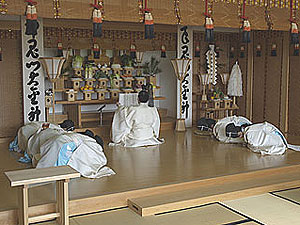
The monthly ceremony of Kobe Branch on Feb. 11, 2007
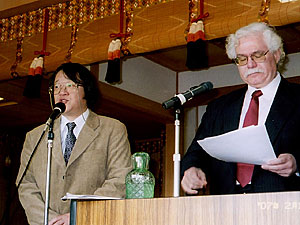
Bill Roberts gave speech at the Kobe branch.
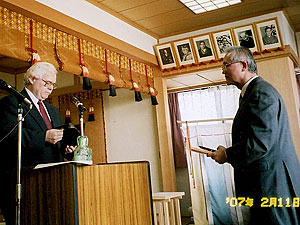
Bill Roberts made a present of his book, “A Portrait of Oomoto” and photo book Meshima to Kobe branch chief.
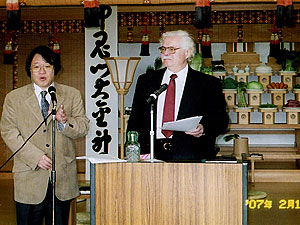
He said "there aren’t Jewish tears or Hindu tears, just human tears. There isn’t Muslim joy and Christian joy, just human joy"
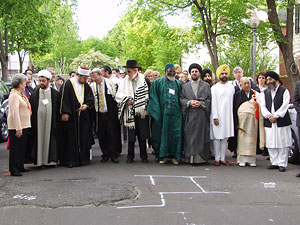
The prayer for peace conference in Washington, D.C., held by the Catholic Sant Egidio organization. Religious leaders parade through the streets of Georgetown in Washington, D.C.
New Contents Thu, May 20, 2010
- Oomoto participates in Sant’Egidio conference : Dialogue among religions and cultures : On divided island nation of Cyprus By Bill Roberts
- Photo Album : Portraits of three branches: Shoko, Tanegashima and Aomori By Bill Roberts
- Oomoto FAQ
- A Letter from Oomoto : Of mountains and myths By Bill Roberts
- Polyglot poem festival The Utamasturi is going international — what’s next? By Bill Roberts
- Ethics education program captures the spirit of Bankyo Dokon By Bill Roberts
- A Letter from Oomoto : A year’s worth of adventure in a summer of branch visits By Bill Roberts
- In Kumamoto, it’s all about water – and fire By Bill Roberts
- A speech by Nevada Taylor at the Kii Branch in Wakayama Prefecture on April 13, 2008.:An Encounter With Oomoto Through Aikido
- Utamatsuri, Poem Festival, in Tokyo(on April 17, 2008)
- A speech by Neil Ryan Walsh at the Kobe branch on Mar. 9th, 2008.:Planting the Seeds of the Soul
- Meeting with the Fifth Spiritual Leader of Oomoto, Madame Kurenai Deguchi by Neil Ryan Walsh
- A speech by Neil Ryan Walsh at the Nagoya branch on Feb. 17th, 2008.:The Japanese Arts beyond National Boundaries
- To the Oomoto branch in Nagoya: City of Eel and Toyota by Neil Ryan Walsh
- A Speech by Nissim Ben Shitrit, Ambassador of Israel on the occasion of the Oomoto Setsubun Grand Festival in Ayabe February 3rd, 2008 : Japan and Israel : Two Lands Balancing the Needs of Traditional Culture and Modern Life. r
- A permanent memorial to Onisaburo (A Speech at the Autumn Grand Festival , November 6, 2007 : )By James Parks Morton, Founder and Chair, Emeritus of The Interfaith Center of New York
- Israel, Palestine and the Power of Poetry(Oomoto believes small efforts can have lasting ripple effects on people and peace)By Bill Roberts
- “Something Great”(This genetics pioneer, a friend of Oomoto, offers a clue to the mystery of life)By Bill Roberts
- Kamishima Cleanup (Harima branch members regularly visit this sacred island to keep the shrine tidy)By Bill Roberts
- Kyotaro Deguchi was one of six recipients of the 2007 James Parks Morton Interfaith Award
What is Oomoto?
- What is Oomoto?
- Spirtual Centers
- Founders and Spiritual Leaders
- History
- Organization and activities
- Teachings and scriptures
- Art Works of Founders and Leaders
Opinions[Archive]
- Statement of regret for the outbreak of war against Iraq (March 20,2003)
- Jinrui Aizenkai dispatched the "Urgent Appeal for a World (Global) Crisis" on March 14.
Grappling with Bioethics[Archive]
- Oomoto’s support for abolishing the death penalty (12, June 2003)
- The Oomoto Foundation protests any birth of a human clone baby. (5, January 2003)
- OOMOTO'S VIEW REGARDING JAPAN’S PERMITION TO THE RESERCH OF HUMAN EMBRYONIC STEM CELLS (ES cells)(12, June 2000)
Vistor’s Review[Archive]
- A speech by Bill Roberts at the Oomoto branch in Hiroshima after its monthly service on March 18, 2007:Encounters with war and peace
- How Bankyo Dokon changed one life by Linda Macphee
- A speech by Bill Roberts at the Hokuriku (Kanazawa) branch on Dec. 3, 2006:Ritual and myth -an encounter with ‘divine madness’
- A speech by Bill Roberts at the Himeji Cultural Center on Feb. 25, 2007:Mesmerized by the Japanese Arts
- A speech by Bill Roberts at the Kobe branch on Feb. 11th, 2007.:There are just human tears and human joy
- A Speech on the occasion of the Oomoto Setsubun Grand Festival in Ayabe February 3rd, 2007 : Egypt's role in Middle East peace
- Keynote Speech for the 28th World Federation Japanese Religionists Conference for World Peace in Tokyo (at Kokugakuin University, Novermber 29, 2006):Vision for Peace in the Middle East By Dr. Munther S. Dajani, Professor Dean, Faculty of Arts, Al Quds University, Jerusalem
- A speech to the Kyoto branch:Spiritual adventures in researching Oomoto leaders
- A Speech at The Oomoto Foundation on Monday, November 6, 2006 : Jordan's role in Middle East By Samir Nouri, Ambassador of the Hashemite Kingdom of Jordan
- A letter from Oomoto:The Young People of Tottori
- A speech by Bill Roberts on the occasion of the dedication ceremony for the new shrine of Tottori Branch By Bill Roberts Oct. 8, 2006
- A speech by Bill Roberts at the Oomoto branch in Hiroshima after its monthly service on March 18, 2007:Encounters with war and peace
- How Bankyo Dokon changed one life by Linda Macphee
- A speech at Setsubun : A Portrait of Oomoto By Bill Roberts Feb. 3, 2006
- New Publication ! By Bill Roberts Feb. 3, 2006 A Portrait of Oomoto
you can read this book in html => http://www.jinruiaizenkai.jp/English/en-kolumno/en-bill/en-sugao/billbook1en.html
E-mail below to order brobert1@ix.netcom.com
Current Topics
- Prayer Offering and World Religious Forum II
- Living the art of dialogue
- Kyotaro Deguchi was one of six recipients of the 2007 James Parks Morton Interfaith Award
Books
Online Books
- Divine Signposts by Onisaburo DEGUCHI
- The Creation of Meaning by Hidemaru Deguchi
- Bankyo Dokon(Seventy years of Inter-Religious Activity at Oomoto)
- Nao Deguchi — A Biography of the Foundress of Oomoto
- The Great Onisaburo Deguchi published by Aiki News
- Bankyo Dokon Seventy Years of Inter-Religious Activity at Oomoto
- Insearch of Meaning
- Nao Deguchi A Biography of the Foundress of Oomoto
- A Portrait of Oomoto By Bill Roberts
Oomoto international Archive
- The History of Oomoto (Jan.– Mar. 1980 — Apr.– Jun. 1982)
- The Ancestors; Friends or Foes? (Apr.– Jun. 1987)
- Tsukinamisai; The Sabbath of Shinto (Jan.– Jun. 1983)
- The Poem Festival at Oomoto; An Ancient Rite Lives Again (Oct.– Dec. 1981)
- Purification of the Universe ; Oomoto's Setsubun Festival (Apr.– Jun. 1981)
Links
Flowers at Ten'on-kyo & Baisho-en (photographs)
Contact
All rights reserved : the Oomoto Foundation Produced by the Netinformational Commission
Since : Mar. 7.1998 Last Update : Thu, May 20, 2010
E-mail : webmaster@oomoto.or.jp
Top Page Nihongo Esperanto Português Roomazi



